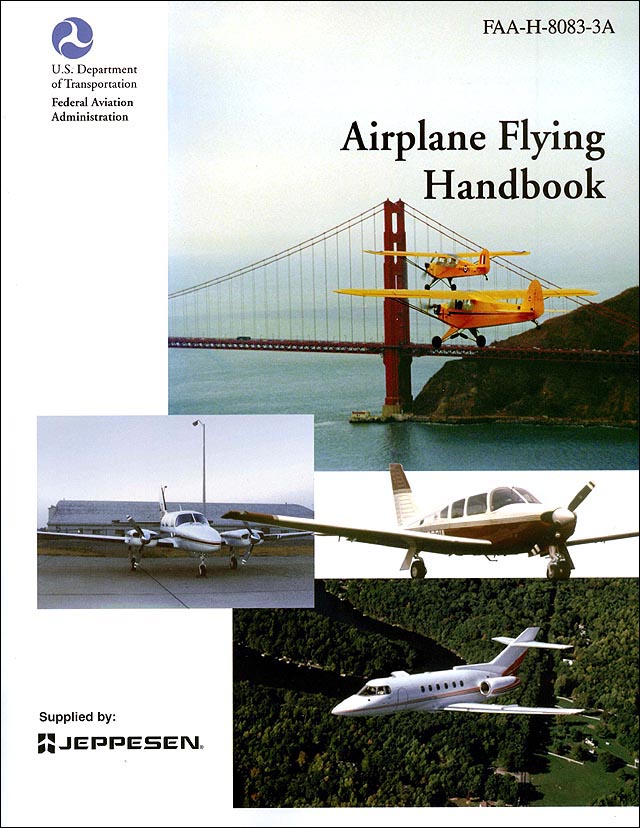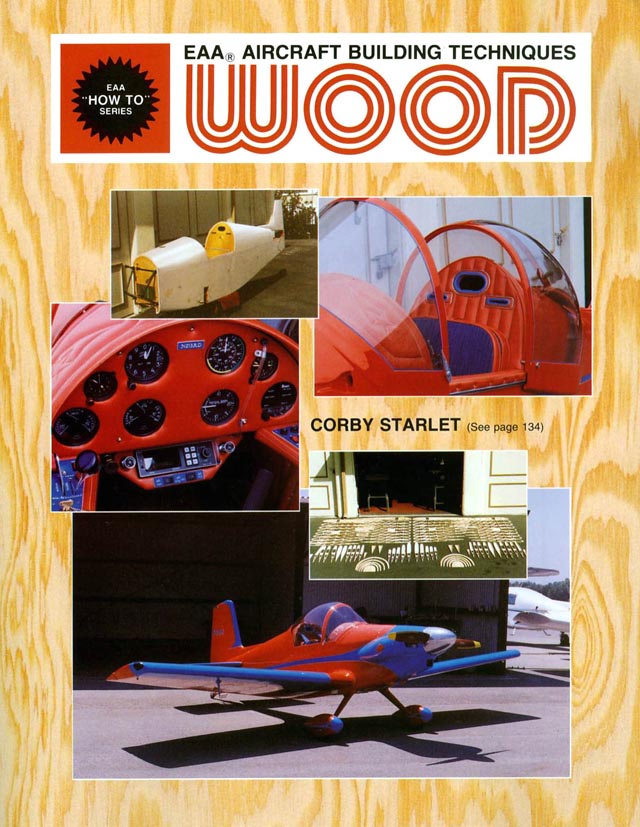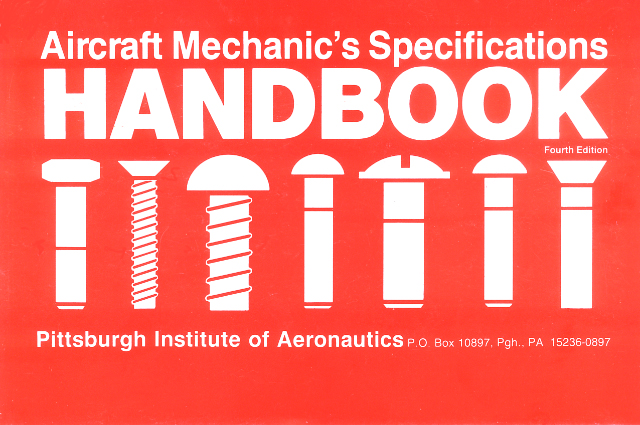Description
This is an excellent book covering many important concepts of flight, and is presented in an manner that presents a lot of important information in a straightforward manner. This book is thoroughly illustrated with full-color photos, diagrams, and charts which clearly explain the topics presented. This book is quite thorough and though no single book could ever cover every conceivable topic in aviation, this one does an excellent job of covering a very broad selection of topics. The discussion on emergency landing (crash) procedures is more in-depth than most flight-training books we’ve seen. This book will make an excellent addition for any pilot’s library and there is much to be learned within it’s pages… and it’s definitely not as “dry” as you might expect from a government-produced publication.
Written by the FAA/DOT (FAA-H-8083-3A), 2004 (Public Domain). ISBN 0-16-072261-6. Published by Jeppesen Sanderson. 272 Pages, Softcover.
Chapters include:
Preface
Table of Contents
1. Introduction to Flight Training
 Purpose of Flight Training Purpose of Flight Training
 Role of the FAA Role of the FAA
 Role of the Pilot Examiner Role of the Pilot Examiner
 Role of the Flight Instructor Role of the Flight Instructor
 Sources of Flight Training Sources of Flight Training
 Practical Test Standards Practical Test Standards
 Flight Safety Practices Flight Safety Practices
 Collision Avoidance Collision Avoidance
 Runway Incursion Avoidance Runway Incursion Avoidance
 Stall Awareness Stall Awareness
 Use of Checklists Use of Checklists
 Positive Transfer of Controls Positive Transfer of Controls
2. Ground Operations
 Visual Inspection Visual Inspection
 Inside the Cockpit Inside the Cockpit
 Outer Wing Surfaces and Tail Section Outer Wing Surfaces and Tail Section
 Fuel and Oil Fuel and Oil
 Landing Gear, Tires, and Brakes Landing Gear, Tires, and Brakes
 Engine and Propeller Engine and Propeller
 Cockpit Management Cockpit Management
 Ground Operations Ground Operations
 Engine Starting Engine Starting
 Hand Propping Hand Propping
 Taxiing Taxiing
 Before Takeoff Check Before Takeoff Check
 After Landing After Landing
 Clear of Runway Clear of Runway
 Parking Parking
 Engine Shutdown Engine Shutdown
 Postflight Postflight
 Securing and Servicing Securing and Servicing
3. Basic Flight Maneuvers
 The Four Fundamentals The Four Fundamentals
 Effects and Use of the Controls Effects and Use of the Controls
 Feel of the Airplane Feel of the Airplane
 Attitude Flying Attitude Flying
 Integrated Flight Instruction Integrated Flight Instruction
 Straight-and-Level Flight Straight-and-Level Flight
 Trim Control Trim Control
 Level Turns Level Turns
 Climbs and Climbing Turns Climbs and Climbing Turns
 Normal Climb Normal Climb
 Best Rate of Climb Best Rate of Climb
 Best Angle of Climb Best Angle of Climb
 Descents and Descending Turns Descents and Descending Turns
 Partial Power Descent Partial Power Descent
 Descent at Minimum Safe Airspeed Descent at Minimum Safe Airspeed
 Glides Glides
 Pitch and Power Pitch and Power
4. Slow Flight, Stalls, and Spins
 Introduction Introduction
 Slow Flight Slow Flight
 Flight at Less than Cruise Airspeeds Flight at Less than Cruise Airspeeds
 Flight at Minimum Controllable Airspeed Flight at Minimum Controllable Airspeed
 Stalls Stalls
 Recognition of Stalls Recognition of Stalls
 Fundamentals of Stall Recovery Fundamentals of Stall Recovery
 Use of Ailerons/Rudder in Stall Recovery Use of Ailerons/Rudder in Stall Recovery
 Stall Characteristics Stall Characteristics
 Approaches to Stalls (Imminent Stalls) -Power-On or Power-Off Approaches to Stalls (Imminent Stalls) -Power-On or Power-Off
 Full Stalls Power-Off Full Stalls Power-Off
 Full Stalls Power-On Full Stalls Power-On
 Secondary Stall Secondary Stall
 Accelerated Stalls Accelerated Stalls
 Cross-Control Stall Cross-Control Stall
 Elevator Trim Stall Elevator Trim Stall
 Spins Spins
 Spin Procedures Spin Procedures
 Entry Phase Entry Phase
 Incipient Phase Incipient Phase
 Developed Phase Developed Phase
 Recovery Phase Recovery Phase
 Intentional Spins Intentional Spins
 Weight and Balance Requirements Weight and Balance Requirements
5. Takeoff and Departure Climbs
 General General
 Terms and Definitions Terms and Definitions
 Prior to Takeoff Prior to Takeoff
 Normal Takeoff Normal Takeoff
 Takeoff Roll Takeoff Roll
 Lift-Off Lift-Off
 Initial Climb Initial Climb
 Crosswind Takeoff Crosswind Takeoff
 Takeoff Roll Takeoff Roll
 Lift-Off Lift-Off
 Initial Climb Initial Climb
 Ground Effect on Takeoff Ground Effect on Takeoff
 Short-Field Takeoff and Maximum Performance Climb Short-Field Takeoff and Maximum Performance Climb
 Takeoff Roll Takeoff Roll
 Lift-Off Lift-Off
 Initial Climb Initial Climb
 Soft/Rough-Field Takeoff and Climb Soft/Rough-Field Takeoff and Climb
 Takeoff Roll Takeoff Roll
 Lift-Off Lift-Off
 Initial Climb Initial Climb
 Rejected Takeoff/Engine Failure Rejected Takeoff/Engine Failure
 Noise Abatement Noise Abatement
6. Ground Reference Maneuvers
 Purpose and Scope Purpose and Scope
 Maneuvering By Reference to Ground Objects Maneuvering By Reference to Ground Objects
 Drift and Ground Track Control Drift and Ground Track Control
 Rectangular Course Rectangular Course
 S-Turns Across a Road S-Turns Across a Road
 Turns Around a Point Turns Around a Point
 Elementary Eights Elementary Eights
 Eights Along a Road Eights Along a Road
 Eights Across a Road Eights Across a Road
 Eights Around Pylons Eights Around Pylons
 Eights-On-Pylons (Pylon Eights) Eights-On-Pylons (Pylon Eights)
7. Airport Traffic Patterns
 Airport Traffic Patterns and Operations Airport Traffic Patterns and Operations
 Standard Airport Traffic Patterns Standard Airport Traffic Patterns
8. Approaches and Landings

 Normal Approach and Landing Normal Approach and Landing
 Base Leg Base Leg
 Final Approach Final Approach
 Use of Flaps Use of Flaps
 Estimating Height and Movement Estimating Height and Movement
 Roundout (Flare) Roundout (Flare)
 Touchdown Touchdown
 After-Landing Roll After-Landing Roll
 Stabilized Approach Concept Stabilized Approach Concept
 Intentional Slips Intentional Slips
  Go-Arounds (Rejected Landings) Go-Arounds (Rejected Landings)
 Power Power
 Attitude Attitude
 Configuration Configuration
 Ground Effect Ground Effect
 Crosswind Approach and Landing Crosswind Approach and Landing
 Crosswind Final Approach Crosswind Final Approach
 Crosswind Roundout (Flare) Crosswind Roundout (Flare)
 Crosswind Touchdown Crosswind Touchdown
 Crosswind After-Landing Roll Crosswind After-Landing Roll
 Maximum Safe Crosswind Velocities Maximum Safe Crosswind Velocities
 Turbulent Air Approach and Landing Turbulent Air Approach and Landing
 Short-Field Approach and Landing Short-Field Approach and Landing
 Soft-Field Approach and Landing Soft-Field Approach and Landing
 Power-Off Accuracy Approaches Power-Off Accuracy Approaches
 90° Power-Off Approach 90° Power-Off Approach
 180° Power-Off Approach 180° Power-Off Approach
 360° Power-Off Approach 360° Power-Off Approach
 Emergency Approaches and Landings (Simulated) Emergency Approaches and Landings (Simulated)
 Faulty Approaches and Landings Faulty Approaches and Landings
 Low Final Approach Low Final Approach
 High Final Approach High Final Approach
 Slow Final Approach Slow Final Approach
 Use of Power Use of Power
 High Roundout High Roundout
 Late or Rapid Roundout Late or Rapid Roundout
 Floating During Roundout Floating During Roundout
 Ballooning During Roundout Ballooning During Roundout
 Bouncing During Touchdown Bouncing During Touchdown
 Porpoising Porpoising
 Wheelbarrowing Wheelbarrowing
 Hard Landing Hard Landing
 Touchdown in a Drift or Crab Touchdown in a Drift or Crab
 Ground Loop Ground Loop
 Wing Rising After Touchdown Wing Rising After Touchdown
 Hydroplaning Hydroplaning
 Dynamic Hydroplaning Dynamic Hydroplaning
 Reverted Rubber Hydroplaning Reverted Rubber Hydroplaning
 Viscous Hydroplaning Viscous Hydroplaning
9. Performance Maneuvers
 Performance Maneuvers Performance Maneuvers
 Steep Turns Steep Turns
 Steep Spiral Steep Spiral
 Chandelle Chandelle
 Lazy Eight Lazy Eight
10. Night Operations
 Night Vision Night Vision
 Night Illusions Night Illusions
 Pilot Equipment Pilot Equipment
 Airplane Equipment and Lighting Airplane Equipment and Lighting
 Airport and Navigation Lighting Aids Airport and Navigation Lighting Aids
 Preparation and Preflight Preparation and Preflight
 Starting, Taxiing, and Runup Starting, Taxiing, and Runup
 Takeoff and Climb Takeoff and Climb
 Orientation and Navigation Orientation and Navigation
 Approaches and Landings Approaches and Landings
 Night Emergencies Night Emergencies
|
|
11. Transition to Complex Airplanes
 High Performance and Complex Airplanes High Performance and Complex Airplanes
 Wing Flaps Wing Flaps
 Function of Flaps Function of Flaps
 Flap Effectiveness Flap Effectiveness
 Operational Procedures Operational Procedures
 Controllable-Pitch Propeller Controllable-Pitch Propeller
 Constant-Speed Propeller Constant-Speed Propeller
 Takeoff, Climb, and Cruise Takeoff, Climb, and Cruise
 Blade Angle Control Blade Angle Control
 Governing Range Governing Range
 Constant-Speed Propeller Operation Constant-Speed Propeller Operation
 Turbocharging Turbocharging
 Ground Boosting vs. Altitude Turbocharging Ground Boosting vs. Altitude Turbocharging
 Operating Characteristics Operating Characteristics
 Heat Management Heat Management
 Turbocharger Failure Turbocharger Failure
 Overboost Condition Overboost Condition
 Low Manifold Pressure Low Manifold Pressure
 Retractable Landing Gear Retractable Landing Gear
 Landing Gear Systems Landing Gear Systems
 Controls and Position Indicators Controls and Position Indicators
 Landing Gear Safety Devices Landing Gear Safety Devices
 Emergency Gear Extension Systems Emergency Gear Extension Systems
 Operational Procedures Operational Procedures
 Preflight Preflight
 Takeoff and Climb Takeoff and Climb
 Approach and Landing Approach and Landing
 Transition Training Transition Training
12. Transition to Multiengine Airplanes
 Multiengine Flight Multiengine Flight
 General General
 Terms and Definitions Terms and Definitions
 Operation of Systems Operation of Systems
 Propellers Propellers
 Propeller Synchronization Propeller Synchronization
 Fuel Crossfeed Fuel Crossfeed
 Combustion Heater Combustion Heater
 Flight Director / Autopilot Flight Director / Autopilot
 Yaw Damper Yaw Damper
 Alternator / Generator Alternator / Generator
 Nose Baggage Compartment Nose Baggage Compartment
 Anti-Icing / Deicing Anti-Icing / Deicing
 Performance and Limitations Performance and Limitations
 Weight and Balance Weight and Balance
 Ground Operation Ground Operation
 Normal and Crosswind Takeoff and Climb Normal and Crosswind Takeoff and Climb
 Level Off and Cruise Level Off and Cruise
 Normal Approach and Landing Normal Approach and Landing
 Crosswind Approach and Landing Crosswind Approach and Landing
 Short-Field Takeoff and Climb Short-Field Takeoff and Climb
 Short-Field Approach and Landing Short-Field Approach and Landing
 Go-Around Go-Around
 Rejected Takeoff Rejected Takeoff
 Engine Failure After Lift-Off Engine Failure After Lift-Off
 Engine Failure During Flight Engine Failure During Flight
 Engine Inoperative Approach and Landing Engine Inoperative Approach and Landing
 Engine Inoperative Flight Principles Engine Inoperative Flight Principles
 Slow Flight Slow Flight
 Stalls Stalls
 Power-Off Stalls (Approach and Landing) Power-Off Stalls (Approach and Landing)
 Power-On Stalls (Takeoff and Departure) Power-On Stalls (Takeoff and Departure)
 Spin Awareness Spin Awareness
 Engine Inoperative – Loss of Directional Control Demonstration Engine Inoperative – Loss of Directional Control Demonstration
 Multiengine Training Considerations Multiengine Training Considerations
13. Transition to Tailwheel Airplanes
 Tailwheel Airplanes Tailwheel Airplanes
 Landing Gear Landing Gear
 Taxiing Taxiing
 Normal Takeoff Roll Normal Takeoff Roll
 Takeoff Takeoff
 Crosswind Takeoff Crosswind Takeoff
 Short-Field Takeoff Short-Field Takeoff
 Soft-Field Takeoff Soft-Field Takeoff
 Touchdown Touchdown
 After-Landing Roll After-Landing Roll
 Crosswind Landing Crosswind Landing
 Crosswind After-Landing Roll Crosswind After-Landing Roll
 Wheel Landing Wheel Landing
 Short-Field Landing Short-Field Landing
 Soft-Field Landing Soft-Field Landing
 Ground Loop Ground Loop
14. Transition to Turbopropeller Powered Airplanes
 General General
 The Gas Turbine Engine The Gas Turbine Engine
 Turboprop Engines Turboprop Engines
 Turboprop Engine Types Turboprop Engine Types
 Fixed Shaft Fixed Shaft
 Split-Shaft / Free Turbine Engine Split-Shaft / Free Turbine Engine
 Reverse Thrust and Beta Range Operations Reverse Thrust and Beta Range Operations
 Turboprop Airplane Electrical Systems Turboprop Airplane Electrical Systems
 Operational Considerations Operational Considerations
 Training Considerations Training Considerations
15. Transition to Jet Powered Airplanes
 General General
 Jet Engine Basics Jet Engine Basics
 Operating the Jet Engine Operating the Jet Engine
 Jet Engine Ignition Jet Engine Ignition
 Continuous Ignition Continuous Ignition
 Fuel Heaters Fuel Heaters
 Setting Power Setting Power
 Thrust to Thrust Lever Relationship Thrust to Thrust Lever Relationship
 Variation of Thrust with RPM Variation of Thrust with RPM
 Slow Acceleration of the Jet Engine Slow Acceleration of the Jet Engine
 Jet Engine Efficiency Jet Engine Efficiency
 Absence of Propeller Effect Absence of Propeller Effect
 Absence of Propeller Slipstream Absence of Propeller Slipstream
 Absence of Propeller Drag Absence of Propeller Drag
 Speed Margins Speed Margins
 Recovery from Overspeed Conditions Recovery from Overspeed Conditions
 Mach Buffet Boundaries Mach Buffet Boundaries
 Low Speed Flight Low Speed Flight
 Stalls Stalls
 Drag Devices Drag Devices
 Thrust Reversers Thrust Reversers
 Pilot Sensations in Jet Flying Pilot Sensations in Jet Flying
 Jet Airplane Takeoff and Climb Jet Airplane Takeoff and Climb
 V-Speeds V-Speeds
 Pre-Takeoff Procedures Pre-Takeoff Procedures
 Takeoff Roll Takeoff Roll
 Rotation and Lift-Off Rotation and Lift-Off
 Initial Climb Initial Climb
 Jet Airplane Approach and Landing Jet Airplane Approach and Landing
 Landing Requirements Landing Requirements
 Landing Speeds Landing Speeds
 Significant Differences Significant Differences
 The Stabilized Approach The Stabilized Approach
 Approach Speed Approach Speed
 Glidepath Control Glidepath Control
 The Flare The Flare
 Touchdown and Rollout Touchdown and Rollout

16. Emergency Procedures
 Emergency Situations Emergency Situations
 Emergency Landings Emergency Landings
 Types of Emergency Landings Types of Emergency Landings
 Psychological Hazards Psychological Hazards
 Basic Safety Concepts Basic Safety Concepts
 General General
 Attitude and Sink Rate Control Attitude and Sink Rate Control
 Terrain Selection Terrain Selection
 Airplane Configuration Airplane Configuration
 Approach Approach
 Terrain Types Terrain Types
 Confined Areas Confined Areas
 Trees (Forest) Trees (Forest)
 Water (Ditching) and Snow Water (Ditching) and Snow
 Engine Failure After Takeoff (Single-Engine) Engine Failure After Takeoff (Single-Engine)
 Emergency Descents Emergency Descents
 In-Flight Fire In-Flight Fire
 Engine Fire Engine Fire
 Electrical Fires Electrical Fires
 Cabin Fire Cabin Fire
 Flight Control Malfunction / Failure Flight Control Malfunction / Failure
 Total Flap Failure Total Flap Failure
 Asymmetric (Split) Flap Asymmetric (Split) Flap
 Loss of Elevator Control Loss of Elevator Control
 Landing Gear Malfunction Landing Gear Malfunction
 Systems Malfunctions Systems Malfunctions
 Electrical System Electrical System
 Pitot-Static System Pitot-Static System
 Abnormal Engine Instrument Indications Abnormal Engine Instrument Indications
 Door Opening In Flight Door Opening In Flight
 Inadvertent VFR Flight Into IMC Inadvertent VFR Flight Into IMC
 General General
 Recognition Recognition
 Maintaining Airplane Control Maintaining Airplane Control
 Attitude Control Attitude Control
 Turns Turns
 Climbs Climbs
 Descents Descents
 Combined Maneuvers Combined Maneuvers
 Transition to Visual Flight Transition to Visual Flight
Glossary
Index |





Reviews
There are no reviews yet.